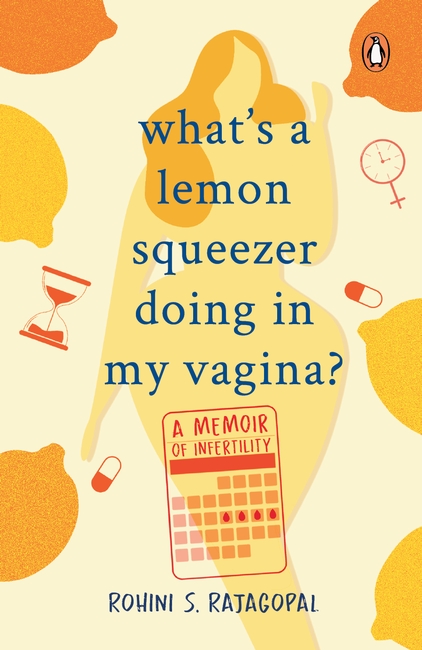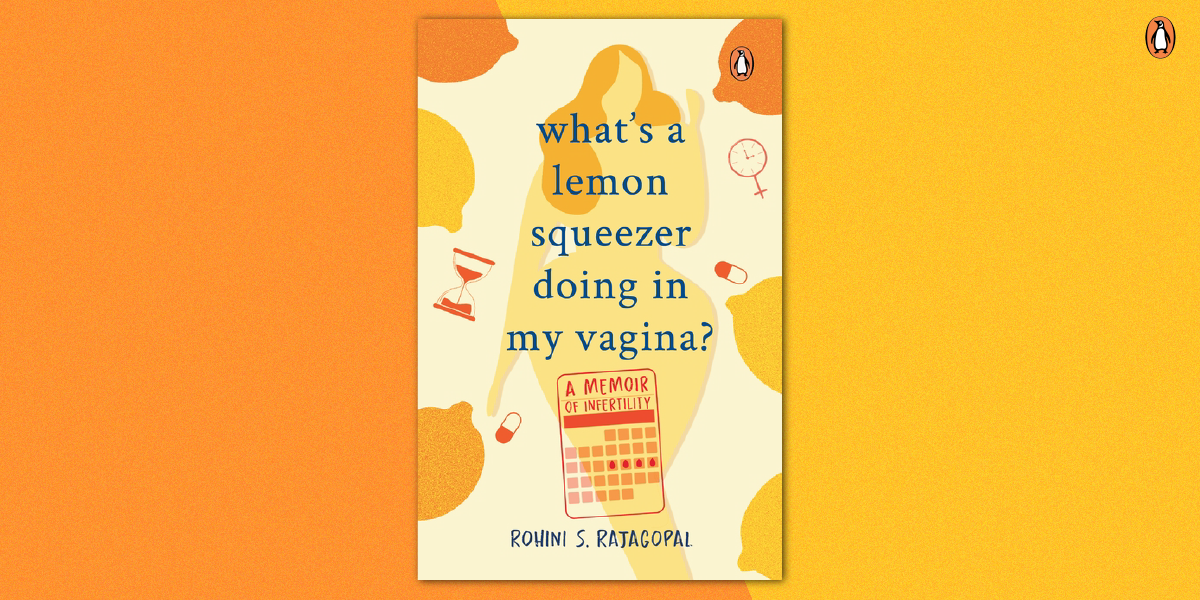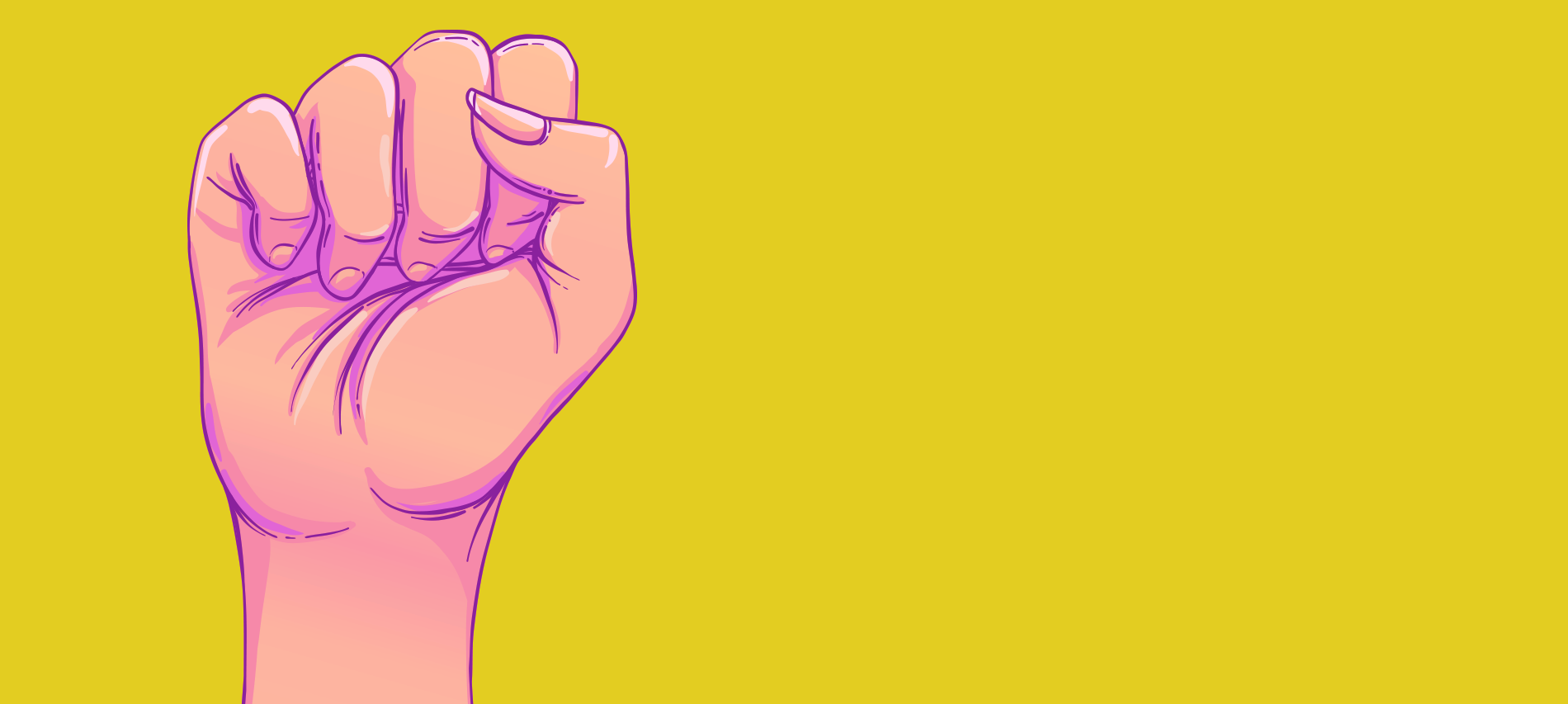What’s a Lemon Squeezer Doing in My Vagina? is a witty, moving and intensely personal retelling of Rohini’s five-year-long battle with infertility, capturing the indignities of medical procedures, the sting of prying questions from friends and strangers, the disproportionate burden of treatment on the woman, the everyday anxieties about wayward hormones, follicles and embryos and the overarching anxiety about the outcome of the treatment.
Here is an excerpt from the chapter where she first encounters a lemon squeezer.
I heard of ‘artificial insemination’ for the first time in a Malayalam movie when I was eight or nine years old. It was Malayalam cinema’s cult classic Dasharatham (1989), which was so ahead of its time that even now I am not sure if its time has come. A leading mainstream actor, Mohanlal, plays a rich, spoilt man-child who decides to act on a whim and have a child through surrogacy. He finds a desperate woman who needs money for her ailing footballer husband’s medical treatment and agrees to rent her womb. They draw up a contract, turn up for the procedure, and fifteen days later she is pregnant! No failed attempts, cancelled cycles or any other complications. With this movie lodged in my brain for reference, I thought fertility treatments were an easy-peasy lemon-squeezy affair. To be fair to the movie, it is not about infertility. It’s about a healthy, fertile couple who use artificial insemination for conception. It may well have happened that quickly and effortlessly in real life too. But the movie glosses over the unseemliness and hardships of the treatment. For those who have seen the movie, I hate to burst your bubble. Welcome to the world of ART.
I began our first IUI in July 2011 with the earnestness of a debutant, expecting early and prompt success. I had not dealt with sickness or physical incapacity in any significant manner until then, being blessed with a constitution that rarely fell prey to illness. I sailed through ten years of school without any noteworthy episodes of fever. My haemoglobin level typically hovered near the fourteen mark. When Ranjith caught the swine flu, despite my being in close contact with him my natural immunity provided the necessary shield against the deadly virus. My good health was my secret pride and I had taken it for granted all my life, expecting the body to tag along in whichever direction I pulled it. Therefore when we started treatment I anticipated the same level of responsiveness and performance from it. But for the first time, my body, specifically the reproductive apparatus, proved to be a terrible let-down, insolently ignoring my instructions.
The procedure itself was relatively simple with only a few key steps. The first step was pills to stimulate my ovaries to release multiple eggs. The second was follicular study. Follicles are tiny fluid-filled balloons in the ovaries that function as the home of the egg. They may expand from the size of a sesame seed (2 millimetres) to the size of a large kidney bean (18 mm to 25 mm) during the course of the menstrual cycle, eventually bursting to push the egg out. The follicles are measured at regular intervals during a cycle to ascertain if they have matured and are ready to release the egg. This is done through a transvaginal ultrasound (TVS).
I was not a big fan of TVS. It involved insertion of a long, slim plastic probe into my vagina and twisting it around to get a close look at the uterus. Magnified images of the uterus appeared on a computer screen. I was appalled the first time when the doctor covered the transducer with a condom and dipped it in lubricating gel, indicating that it had to enter an orifice in my body. I thought that scans, by definition, were non-invasive. It caused some discomfort, but it was not very painful. Eventually, I learnt to relax my muscles and spread my legs far apart to make things easier. I wished I didn’t have to get a TVS, but if I had to then I could tolerate it.
The cycle got off on the wrong foot from the very beginning. The first ultrasound showed only one big-enough follicular blob (at 13 mm). The other four or five follicles were too small, indicating they might not reach maturity. This meant I might have only one egg despite taking drugs to stimulate the release of many.
In the next ultrasound, my ovarian plight did not show improvement. The lead follicle was still only at 15 mm (way below the 18 mm mark of maturity) and the others had not grown at all, looking like they were giving up on ovulation altogether.
There were no outward symptoms to show if the follicles were fattening or dying (this is true for most reproductive processes). So at every ultrasound I went in expecting miracle growth, only to be told that my seeds were lagging poorly behind. I felt helpless at the response from my body because there was nothing I could do to expand the follicles. If it were an outwardly manifest condition I could have applied my inner reserves of resolve and determination to improve the outcomes, in the same way that I would do daily exercise and physiotherapy to regain strength in an injured leg. But my action, or inaction, had no bearing on the ungovernable follicles.
We waited a couple of more days and did a third ultrasound. This time the news was worse. The lead follicle had ruptured; it hadn’t waited for the others to catch up or even to reach its own full maturity. There was nothing left to do but to hurriedly put the sperm inside the uterus since an egg (presumably underdeveloped) had arrived and was waiting. The sperm transfer was scheduled for the same day.

I rang up my manager and said I would be taking the day off to address a personal emergency. An hour later, Ranjith drove in from his office to give a semen sample. He came in, gave the semen sample and left. He did not stay any longer because he had meetings that could not be rescheduled at such short notice.
I had come to the clinic at eight in the morning assuming I would just pop in for the ultrasound and pop out. An easy day with only the bother of TVS. But when I heard that I would have to stay back for the IUI, I inwardly experienced a mini-heart attack. Early on, while describing the procedure, Dr Leela had mentioned that the sperm would be injected inside the uterus using a catheter. Having heard the words ‘inject’ and ‘catheter’ in conjunction with my vagina, I thought it best to look up the process in detail on the Internet. One of the first search results showed that during an IUI the doctor uses a ‘speculum’ to pass the catheter into the uterus. It was a surgical instrument inserted inside the vagina or anus to dilate the area and give the doctor a better view. I did a quick search on Google Images to know what it looked like. The photos that flashed on my screen sent ripples of shock through
my system. It looked like the stainless-steel lemon squeezer found in a kitchen. It was made of metal and about the same size as the kitchen tool. It had two blades to widen and hold open the vagina and a third handle with a screw to lock the instrument into place.
What’s a Lemon Squeezer Doing in my Vagina offers a no-holds-barred view of Rohini S. Rajagopal’s circuitous and highly bumpy road to motherhood.















